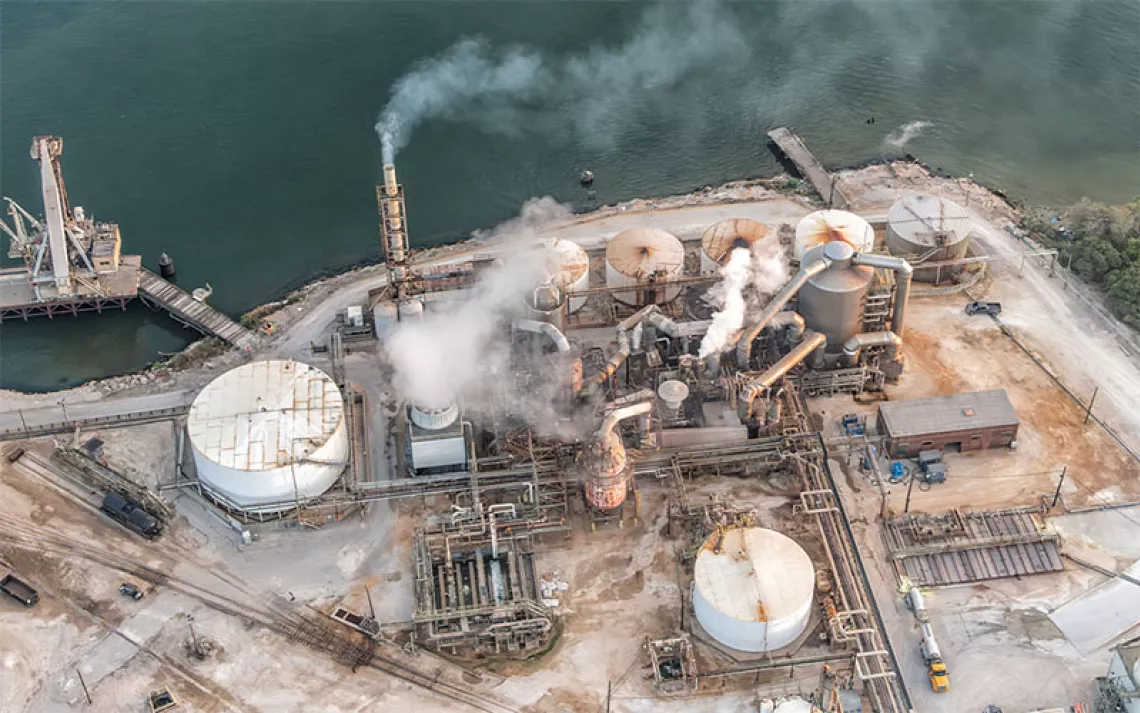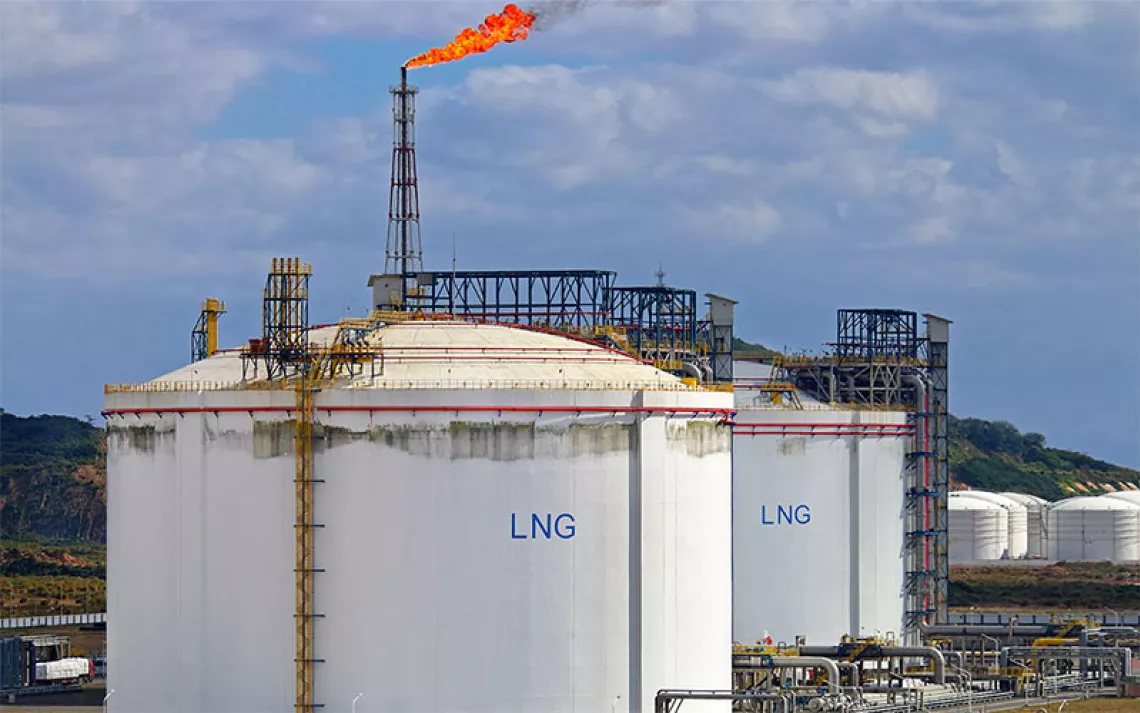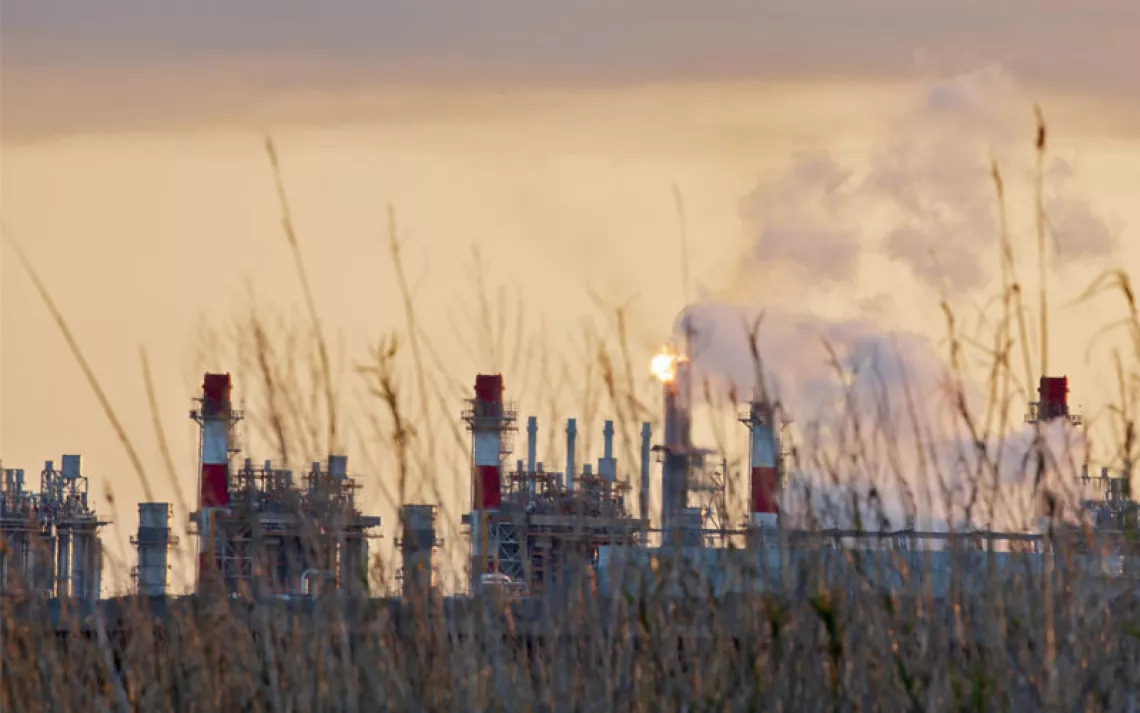Halting the Gas Export Boom
On Louisiana's Gulf Coast, the fossil fuel industry is planning a massive expansion of LNG exports. One woman is determined to stop them.
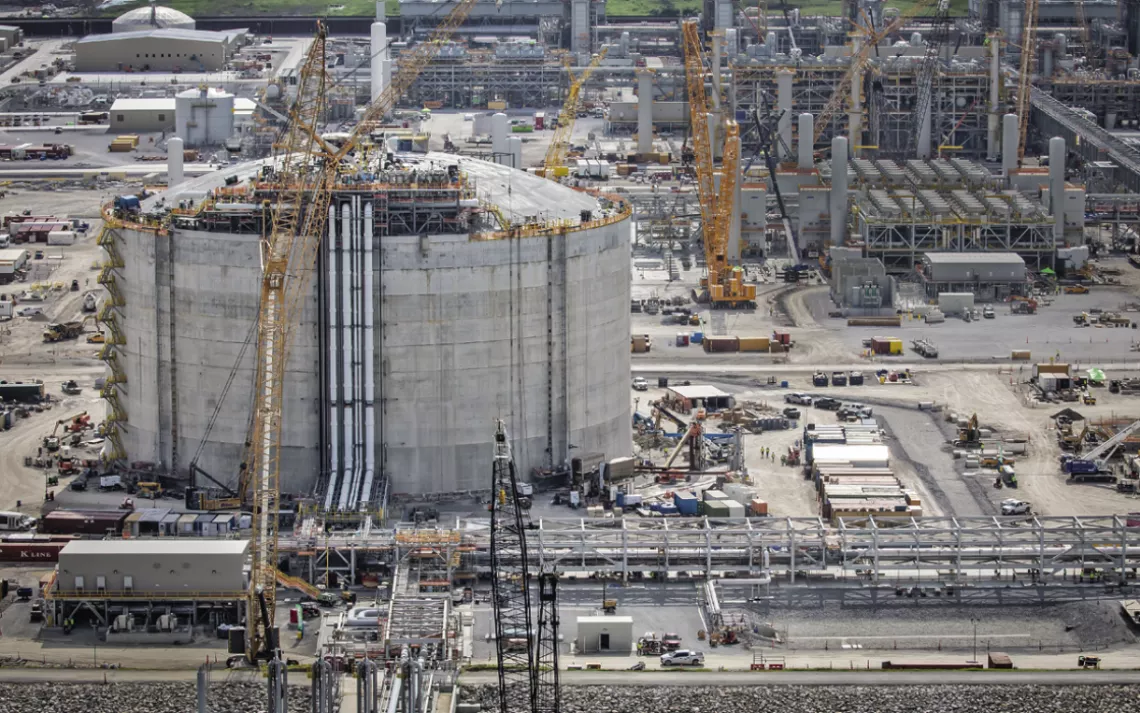
The Venture Global Calcasieu Pass export terminal, under construction in Cameron Parish. | Photos by Julie Dermansky/Southwings
LAKE CHARLES IS A SMALL CITY of some 80,000 people located in the southwest corner of Louisiana, not far from the Texas border. On the surface, it might seem tailor-made for a massive new build-out of industrial facilities designed to export gas. There's plenty of gas produced in the region, there's a well-developed network of pipelines to deliver the fuel from fracking fields farther away, and the Gulf of Mexico is just 35 miles due south, offering a portal to overseas markets. Lake Charles is also situated in the heart of Trump country, and local and state governments have long been committed to the fossil fuel industry. Incidents of local resistance to fossil fuel and chemical corporations have been few and far between, and resolutely squashed. Today, no national environmental groups have a presence in Lake Charles, where nearly half the residents are Black.
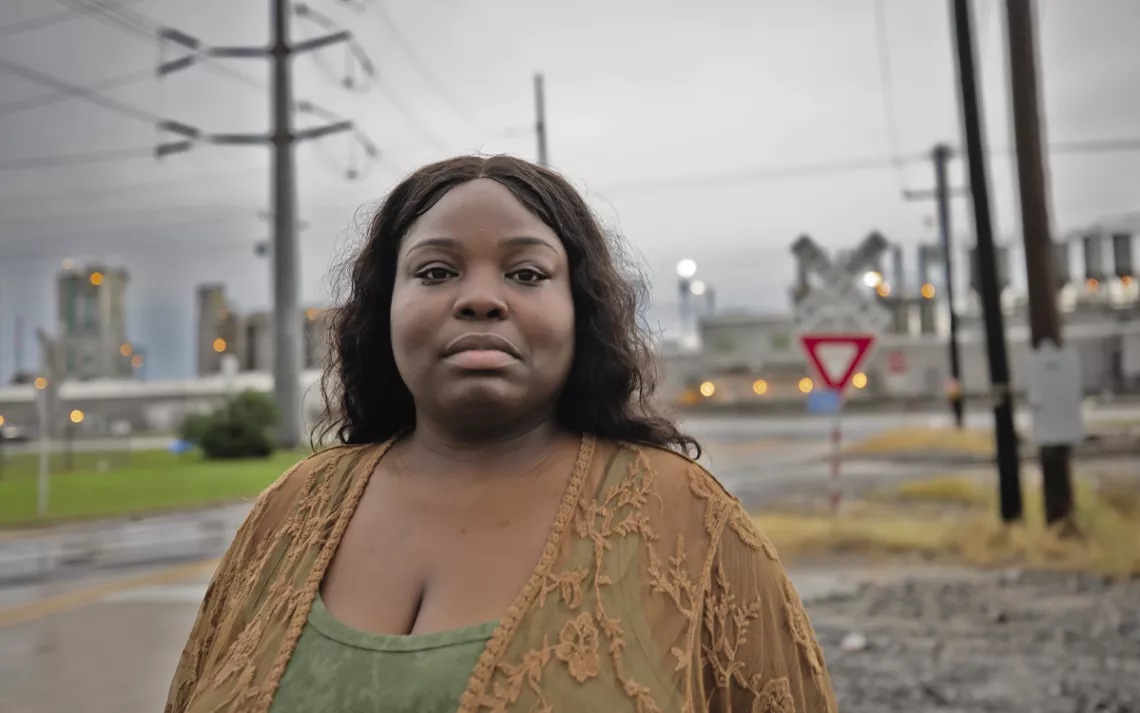
Roishetta Ozane has waged a campaign to halt the construction of gas export facilities near Lake Charles, Louisiana.
In announcing plans for a liquefied natural gas (LNG) "center of excellence" in Lake Charles last March, Mayor Nic Hunter, a Republican, said, "The growth of Southwest Louisiana's LNG industrial complex has put our region on the map and gained us a seat at the global table in recent years." George Swift, president and CEO of the Southwest Louisiana Economic Development Alliance, the leading business network in the Lake Charles area, predicts that "Louisiana could be the LNG export capital of the world."
So it must have come as quite an unwelcome shock to a who's who of large energy companies when local resident Roishetta Ozane started showing up to put a kink in their plans—virtually a lone voice against the LNG build-out. "My mission is to ensure that Southwest Louisiana, specifically Lake Charles and the surrounding areas, aren't made into a climate sacrifice zone," Ozane says.
Ozane is 37, with round cheeks, warm brown eyes, and an easy laugh. She grew up in Ruleville, in the heart of the Mississippi Delta, and her early life was shaped by poverty. But it was also sculpted by powerful Black women. Civil rights movement stalwart Fannie Lou Hamer is a local icon. Ozane's grandmother led community efforts to introduce Head Start, her aunt was a longtime civic leader who was elected mayor, and her single-parent mother overcame a host of adversities to care for her family, eventually moving them to Lake Charles.
Ozane's life has also been transformed by hurricanes. After Hurricane Katrina smashed through Louisiana in 2005, many evacuees who fled to Lake Charles sheltered at the Harrah's casino where Ozane worked. When she found herself coordinating relief services, she discovered her calling. "I felt like I now knew what I was supposed to be doing," she says. "Helping people, organizing." Soon enough, Ozane needed support herself. Hurricane Rita struck the region just one month later, and Lake Charles was in the eye of the storm. Ozane and her family lost everything. She eventually rebuilt and crafted a career serving others as a health worker, a teacher, and a community advocate.
When the Cajun Navy—an all-volunteer relief organization best known for its burly ex-military men who show up to assist locals in times of disaster—needed help supporting people in the wake of the deep freeze last February, they knew to call on Ozane. She had recently established a small volunteer nonprofit aid organization, the Vessel Project, with Dominique Darbonne, and she had earned a reputation as a steadfast anchor in times of emergency.
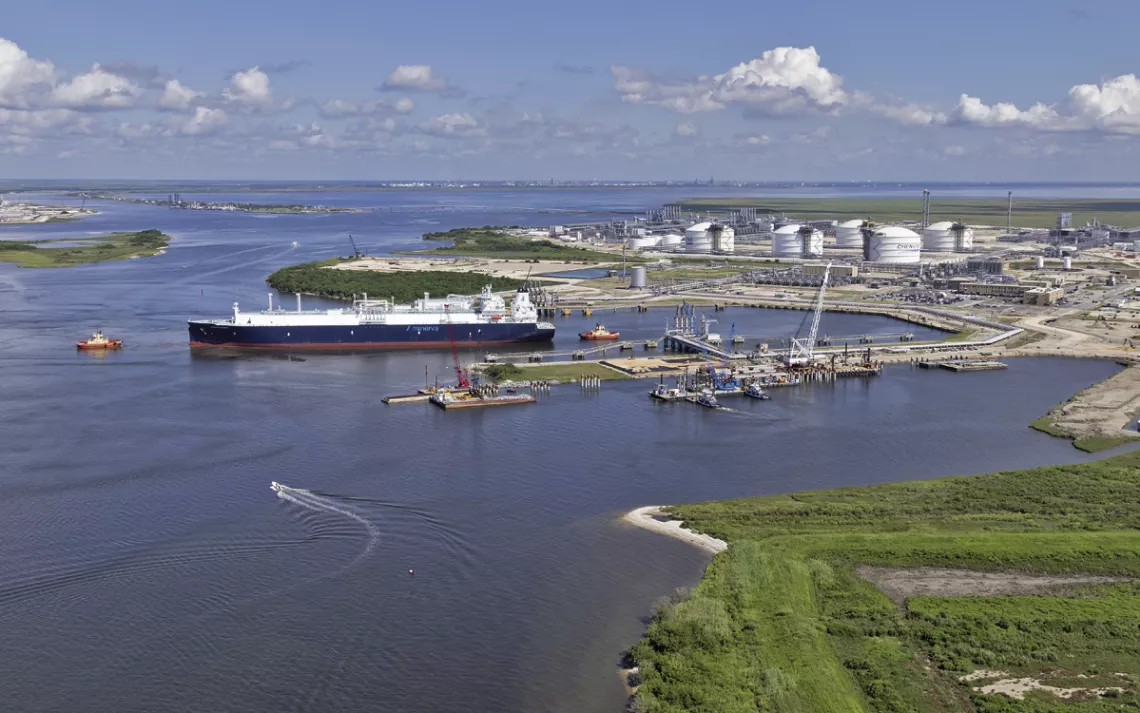
The Cheniere LNG plant at Sabine Pass.
That same month, Ozane began work as a local community organizer for the Louisiana nonprofit Healthy Gulf. In August, she was hired for a similar role with the Anthropocene Alliance—a national network of frontline activists confronting environmental and climate injustice. She is determined to root out the cause of the climate chaos swirling around her—namely, the expansion of the fossil fuel industry. "These '100 year' storms keep happening, and they're only going to get worse if we continue to let these industries come in here and build all around us," Ozane warns.
More than two dozen fossil fuel and petrochemical companies already operate in Lake Charles, including seven of Louisiana's top 50 polluters. Both national and local commentators are quick to draw the links between extreme weather events and worsening climate change. But observers far less often, and certainly not frequently enough for Ozane, call attention to the poisonous environment wrought by the companies that cause it.
"You have ConocoPhillips, Phillips 66, Westlake Chemical, Sasol, Indorama, Firestone, CB&I. And Cameron LNG is not far from me," Ozane says. In the course of their routine operations, the oil refineries, petrochemical plants, and LNG facilities release air pollutants, including sulfur dioxide, nitrogen oxides, volatile organic compounds, microscopic soot, and carbon monoxide. These pollutants are known to cause asthma, respiratory diseases, heart disease, preterm births, and cancer. "We know they're releasing some sort of chemicals," Ozane says. "We're breathing it in. It's getting inside of our bodies, and you know it's not safe in the long run. You might feel, 'OK, it's safe now.' But people who have to live near them who have no other choice or can't move, like me, . . . just have to stay here and breathe it in."
And then there are the all-too-regular industrial accidents. Ozane is a single mother of six children—ages three to 18—and the family currently lives in a Federal Emergency Management Agency trailer. On the night of September 27, an explosion and fire at the Westlake Chemical plant two miles away sent six workers to the hospital. Sirens from ambulances and fire trucks kept her children up until about 3 A.M. But it doesn't take an explosion to make life unbearable for the plants' neighbors. "They flare at night every night," Ozane says. "It's never dark in Southwest Louisiana, because the skies are lit up from the industries. We call it the 'second sunrise.'"
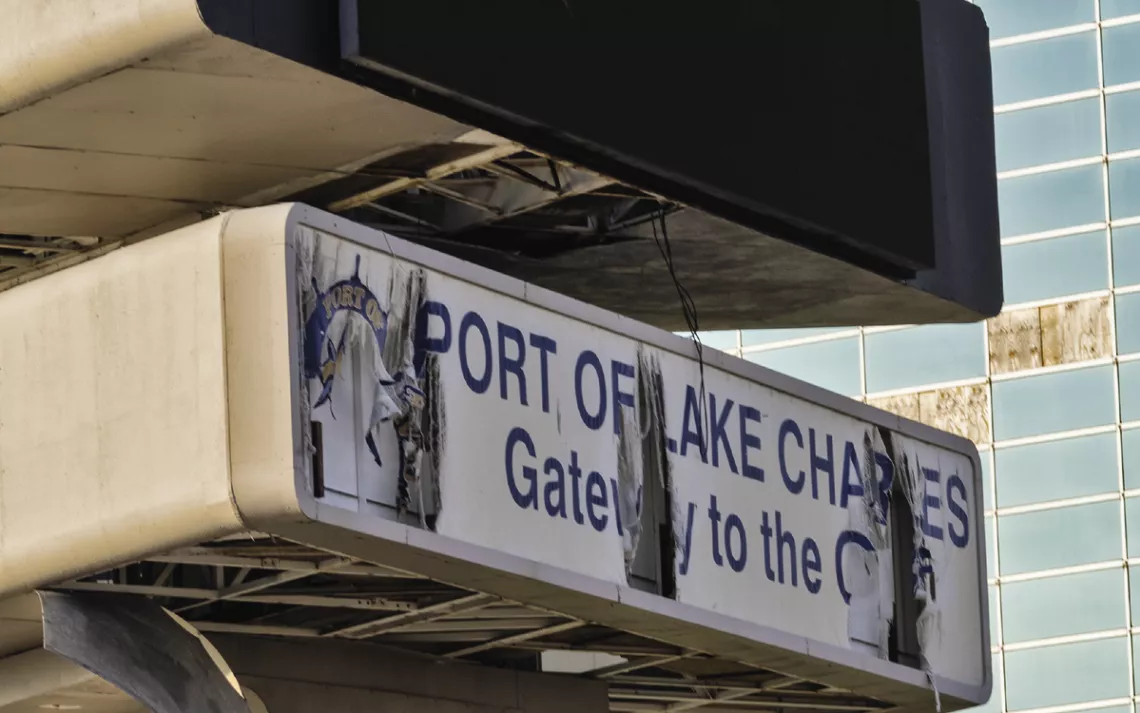
An office building in Lake Charles still has some windows boarded up a year after Hurricane Laura hit.
One night last August, Ozane stepped outside to the sight of a giant yellow fireball blazing in the dark sky. Although the flares were more than a mile away, Ozane says, they were so large that they appeared to be burning just at the end of the row of FEMA trailers. "Welcome to my life," she says. She sighs before breaking into a self-conscious chuckle. "I have to laugh to keep from crying a lot of times."
Ozane is organizing to ensure that no new fossil fuel facilities come to Lake Charles, starting with the planned LNG export operations. The rush to build out gas export facilities in Southwest Louisiana is part of a nationwide push. Today, there are six fully operational LNG export facilities in the United States. If the fossil fuel companies get their way, that number will increase to 23 in the next few years, with 17 located in the Gulf of Mexico alone. Were they to become operational, the new and expanded facilities would have the potential to release more than 109 million tons of greenhouse gases annually. That's more climate-warming pollution than is released from 25 coal-fired power plants, according to an analysis by the Environmental Integrity Project.
Across the nation, advocates for public health and environmental and climate justice are organizing to halt the expansion, teaming up with allies from around the world. Ozane is intent on bringing Lake Charles into that larger effort. Allied against her are most of the elected officials in her state, many of her fellow residents, and a fossil fuel industry determined to secure its own survival.
AS YOU DRIVE SOUTH from Lake Charles on Highway 27 toward the Gulf of Mexico, the landscape rapidly shifts from the gray of industrial refineries to a dazzling green and blue that disappear into the ocean horizon. Lush coastal marsh is interspersed with bayous, lakes, and ponds. The occasional cypress stands among the grasses, and birds are everywhere—wading, resting on reeds, hovering over the waterways. Families can be seen fishing, crabbing, hunting, and just relaxing in the shade. Keep going and you'll soon reach Sabine National Wildlife Refuge, home to threatened and endangered species including West Indian manatees, Atlantic sturgeon, and leatherback and Kemp's ridley sea turtles.
It is thus a shock when, just before the wildlife refuge, three giant white concrete cylinders emerge from the wetlands. Each is more than 18 stories high, over 250 feet in diameter, and capable of holding more than 42 million gallons of LNG. The sprawling Cameron LNG facility appears like an industrial mirage: some 120 acres of concrete paved atop the wetlands, a host to pipelines, steel infrastructure, and fields of flare stacks.
This massive scale is required given the complexity of turning a fossil fuel from a gas into a liquid. To reach the facility, most gas travels by pipelines (though some LNG moves by rail and truck), crisscrossing the length and width of the nation to arrive at the Gulf. Once it gets to a plant, the gas is typically pumped through a series of compartments in which compounds such as mercury, hydrogen sulfide, carbon dioxide, benzene, ethane, propane, and butane are removed. During this process, so much "waste" is produced that the operations require multiple flare arrays that release and burn methane and other pollutants. Chemicals including nitrogen, methane, ethylene, and propane are then used to super-cool the remaining product to -162°C, the temperature at which the gas converts to a liquid. The now-liquefied gas is then stored in enormous cylinders like those you can see from Louisiana's Highway 27.
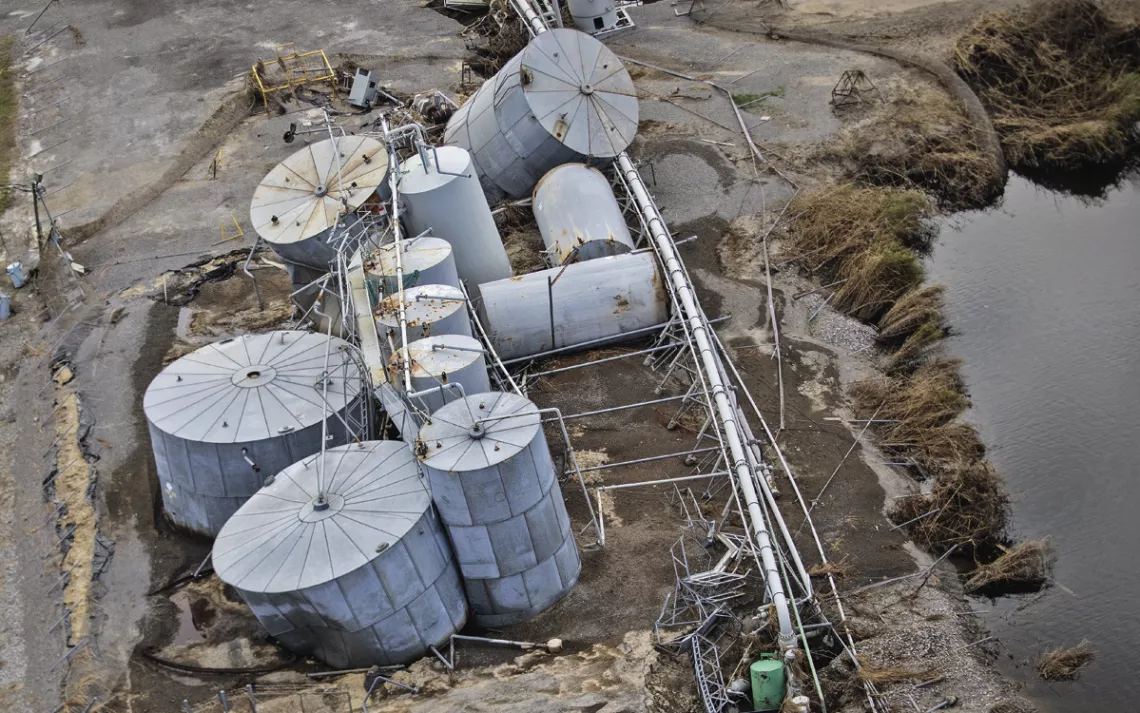
An oil and gas facility in Cameron Parish was one of many that sustained serious damage from Hurricane Laura.
The final step is loading the LNG onto ships for transport. These are no ordinary ships. Specially designed to carry LNG, they are like nothing this journalist has ever seen before. Take the Diamond Gas Sakura, an LNG vessel often docked at Cameron LNG. At nearly a thousand feet long, it is the equivalent of three football fields laid end to end, with a deadweight of approximately 73,000 tons. The deck is dominated by a mammoth blocklike structure that holds the LNG, and which brings to mind the starkly dehumanized industrial cubist art of the early 20th century.
Cameron LNG derives its name from the parish within which it resides, and on its website the company describes itself as "a small local company with a large global impact." But that's a ruse. Cameron's owners are neither small nor local. They include some of the largest corporations in the world: France's TotalEnergies; Japan's Mitsui & Co. and Japan LNG Investment, a company jointly owned by Mitsubishi Corporation and Nippon Yusen Kabushiki Kaisha; and California-based Sempra LNG, a subsidiary of Sempra Energy, a $66 billion energy conglomerate. Similarly, the proposed Lake Charles LNG plant and export terminal is a project of Energy Transfer, the Texas company behind the Dakota Access and Bayou Bridge Pipelines. Just across the border in Texas, the Golden Pass LNG terminal—a partnership between ExxonMobil and Qatar Petroleum—is undergoing a massive expansion.
Cameron LNG is also expanding and will roughly quadruple its footprint atop the wetlands to more than 500 acres. Although the facility is already awesome in size and scale, it's a miniature version of Louisiana's other operating LNG export terminal. About an hour's drive due west, the 1,000-acre Cheniere Energy Sabine Pass complex on the border with Texas is the largest LNG export terminal in the United States. Plagued by long-standing safety violations, the company was fined $2.2 million in August 2021 by federal regulators to address the hazards. An investigation of the incidents by the Center for Public Integrity concluded that federal regulations had failed to keep pace with the LNG export boom, that rules had been "written for simpler import and gas-storage facilities, not complex, multibillion-dollar export facilities."
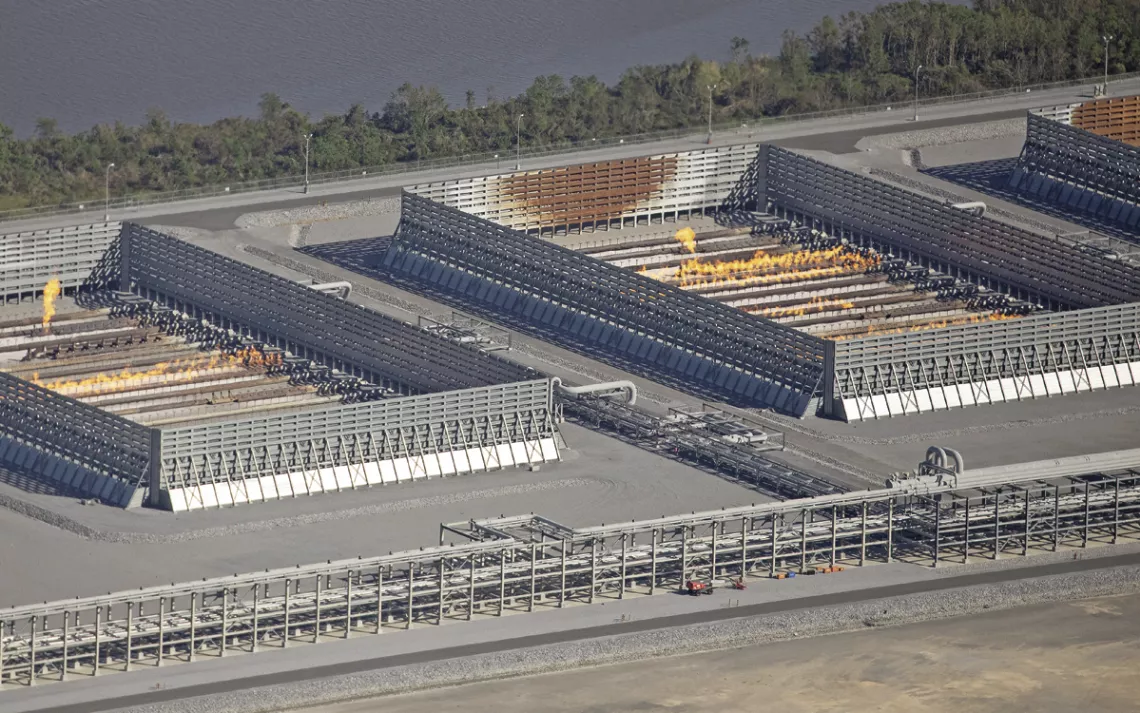
Gas flaring at Cameron LNG in October 2020 following Hurricane Delta.
LNG export terminals "are among the largest capital projects ever attempted in modern industry, including some projects costing over $30 billion," reports Global Energy Monitor. Companies are willing to make such investments, ironically enough, because the fossil fuel industry is facing its worst existential threat in 150 years. US frackers have never been profitable, and the pool of financial backers willing to float their production losses is shrinking. The growth in demand for fossil fuels was already falling before the COVID-19 pandemic caused a deeper dip. In 2020, more than 100 US and Canadian oil and gas companies declared bankruptcy, more than double the number that did so in the previous year. A dwindling number of customers, primarily based in East Asia and parts of Europe, now compose the market for an increasingly unpopular product.
"US frackers are looking for a reason to exist," says Naomi Yoder, a staff scientist with Healthy Gulf. The LNG export build-out is designed to provide a much-needed market for their gas, most of which was shipped to South Korea, Japan, China, and Spain in 2020.
Longtime Sierra Club organizer Darryl Malek-Wiley of New Orleans admits to feeling a "reverse déjà vu" while looking at the industry's current proposals to build export facilities. He recalls the early 2000s, when the fossil fuel industry was trying to build some 20 LNG import terminals on the Gulf Coast. "We fought them on the land, and we fought them on the sea," the 71-year-old recalls. At that time, the Sierra Club teamed up with fellow environmentalists and recreational and commercial fishermen ("two groups who usually don't even speak to each other," Malek-Wiley says) and succeeded in stopping virtually all the proposed import terminals.
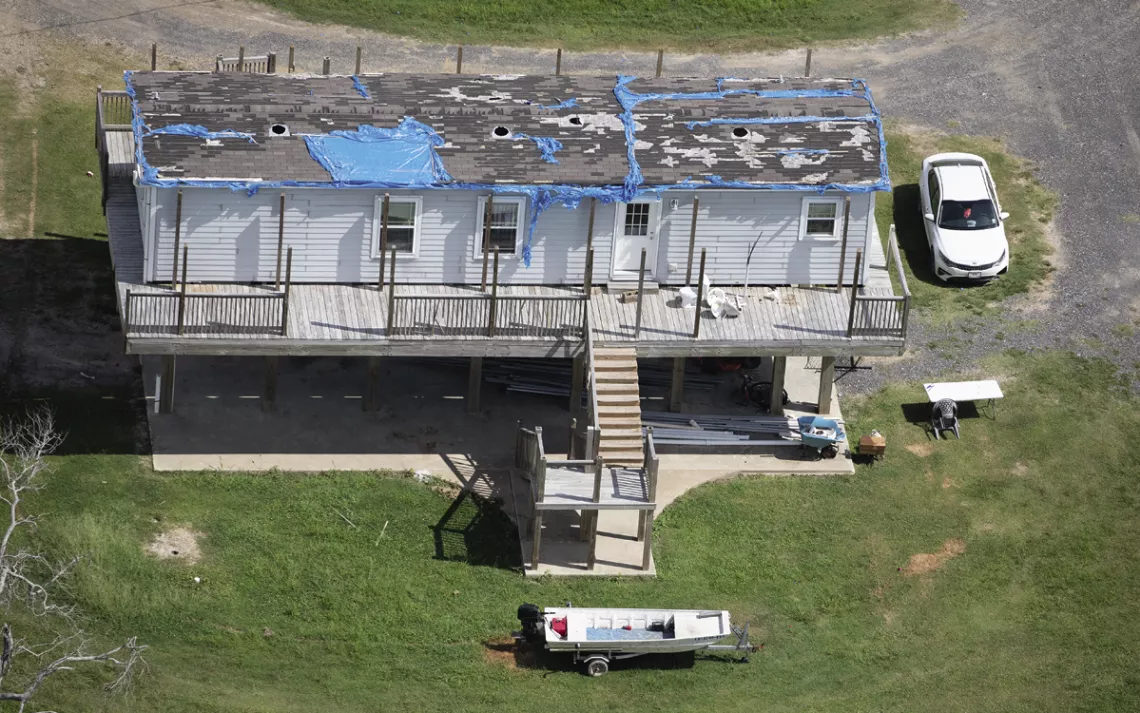
Months after Hurricane Delta hit, many residences in the Lake Charles area were still in disrepair.
Some five years later, the fracking boom took off in the United States, leaving the nation awash in gas, and in the process, entirely upending the global market. Plans for imports were then replaced with plans for exports. The first ships departed from Cheniere's Sabine Pass terminal in 2016, kicking off a steady climb in US LNG exports. By early 2018, the country was a net exporter of gas, with exports hitting a record high in July 2018. Under President Donald Trump, the volume of exported gas had more than doubled by January 2020. The brief pandemic-related collapse in July 2020 was short-lived. LNG exports set a new historic high in March 2021, with the majority of US exports departing from Louisiana.
Yoder sees doom in this expansion. The increasing LNG exports act as a significant impediment to the global clean energy transition by taking investment dollars and policy support away from renewable energy in favor of gas. When considering the proposals for new LNG export facilities, Yoder says, "The environmental consequences of such a scenario are staggering."
IT STRIKES ROISHETTA OZANE as more than a bit ironic that the FEMA trailer park where she now resides was built to serve as a "man camp," housing men who worked at the fossil fuel refineries and petrochemical plants and at Cameron LNG. Like most of the trailer park's residents, who are mostly Black, Ozane was displaced from her home by Hurricane Laura. The August 2020 Category 4 storm killed 31 people in Louisiana and damaged virtually every building in and around Lake Charles, including Ozane's rental home. Six weeks later, Hurricane Delta struck. On May 15, 2021, a historic flood swept through the area.
A visitor to Lake Charles last summer would be forgiven for thinking that any one of these events had happened just days, rather than months, earlier. In July, blue tarps were still draped over storm-damaged roofs, roads were lined with the skeletal remains of billboards and storefront signs, piles of rubble from collapsed buildings dotted the streets, and, just past the nearby community of Hackberry, a downed and twisted electricity transmission tower was sprawled on the ground.
"It's just so much," Ozane says as she talks about the confluence of climate-change-intensified storms and pollution brought about by the fossil fuel companies. They "stamp out natural resources" and are "building on our wetlands," she says. Her voice momentarily trails off, sadness creeping in as if the weight of the information she's about to impart takes its toll before the words can come out. "This city could just get wiped away," she says.
Like many residents of Lake Charles, Ozane's children have few options for escaping "the plants," as the fossil fuel and petrochemical operations are known. The best refuge is the nearby wetlands. "My children find solace there," Ozane says. Catching garfish is a favorite pastime. "It has a texture almost like chicken, but it's more meaty," she explains. It's also a challenge, "almost like catching an alligator," she adds. "You have to hook it and make sure that it doesn't bite you, because it also has teeth." She often cooks what her sons catch. For many local residents, fishing is a primary source of sustenance and income.
The wetlands are also where the LNG facilities have decided to make their home. As her community organizing has deepened, Ozane has learned more than she ever expected about the causes and consequences of hurricanes. The coastal wetlands, she has come to find, are not just places of solace but also a key defense against hurricanes and tropical storms. "Our wetlands are our biggest protection against the storm surge," she explains. "If we didn't have those wetlands, the storm surge would have been bigger and would have wiped us off the map."
In Louisiana alone, the proposed new LNG build-out would impact over 2,000 acres of wetlands, according to Healthy Gulf's Yoder. Wetlands serve a host of crucial functions. They act as natural sponges that trap floodwaters by lowering flood heights and dissipating storm surges while also absorbing and storing large quantities of CO2 from the atmosphere. Wetlands also hold sediments in place—an essential tool in Louisiana's desperate fight against coastal erosion.
Louisiana loses the equivalent of one football field of land every 100 minutes to coastal erosion. As much as 60 percent of this loss is due to the canals and waterways built over the course of decades to support and continuously expand the fossil fuel industry. Most of the land on which LNG plants are located, or are planned to be built, is expected to disappear into the Gulf of Mexico within the next 50 years. State and federal agencies are currently spending billions of dollars to expand and protect the state's wetlands—even as industrial incursions into the wetlands continue.
"There is certainly no justification for destroying thousands of acres of Gulf Coast wetlands that would buffer the effect of hurricanes, and hurricanes are only getting more frequent and more intense," Yoder says. "LNG terminals spew incredible amounts of greenhouse gases, which drive those worsening storms. It's an insidious, absurd cycle that should not be allowed to continue."
The plants' presence atop the wetlands is a threat to the facilities themselves. Hurricane Laura slammed into the Venture Global Calcasieu Pass LNG plant, which is under construction atop wetlands east of the Sabine National Wildlife Refuge, causing damage to the site. The hurricane caused flooding at Cameron LNG and knocked out its power for over a month. For weeks following the storm, Healthy Gulf received photos taken by worried nearby residents, who described large flares "that looked like fireballs in the sky." Days after Cameron finally resumed operations in October 2020, Hurricane Delta hit, forcing it offline yet again.
In response to questions from Sierra, Cameron LNG said its current location is "ideal" given its access to the Gulf of Mexico and a skilled workforce. "We have engineered resilience into Cameron LNG, borne out of last year's hurricanes as the facility encountered minimal damage," a company spokesperson wrote.
Anne Rolfes of the Louisiana Bucket Brigade, a New Orleans–based nonprofit, worries about the near-total lack of attention being paid by media and others to the industrial expansion underway in Southwest Louisiana. "The build-out is happening! Every month, at least, we're getting an announcement of a new facility," Rolfes says, frustration mounting in her voice. "Yet you'd never know it, reading the news, unless it's a press release for the industry in a local paper."
Ozane is convinced that a toxic mix of wetlands destruction, worsening extreme weather events, deadly pollution, and industry ill intent can only result in utter devastation. She points to nearby Mossville as an example of what could happen. Mossville was once a thriving African American community founded by formerly enslaved people. Now, Ozane says, "if a person has never heard of Mossville, or doesn't know about it, when they come here, they won't know [it existed]." Petrochemical companies led by the South African–based multinational Sasol had increasingly sought to extend their operations in the area. At first, the industrial operations surrounded Mossville; eventually, they subsumed it. Pushed out by pollution, sickness, death, storms, and company buyouts, almost everyone left. Today, a mere handful of residents remain.
"We're going to be wiped off the map," Ozane says, stating her darkest fear.
WHILE FOSSIL FUEL COMPANIES are rushing to construct new LNG infrastructure in southern Louisiana, the long-term future of LNG exports is not at all certain. In recent years, communities across the United States have racked up a string of victories against planned LNG facilities. In Oregon, the Jordan Cove and Pacific Connector LNG export project was officially placed on pause last May after years of local resistance and organizing. In August, local organizers in Florida defeated the plans of Strom Inc. to build a liquefaction facility in Crystal River and transport the LNG to Port Tampa Bay for export.
Two other high-profile wins over the gas industry occurred last spring. In May, Sempra Energy said it would delay a decision about building a proposed terminal in Port Arthur, Texas. Two months earlier, Annova LNG went further, abandoning its plans for an LNG export plant in Brownsville, Texas.
Bekah Hinojosa, the Sierra Club's Gulf Coast campaign representative, says that those victories came after years of organizing along the Gulf coastline. Like her parents, Hinojosa was born and raised in the Rio Grande Valley. She describes the primarily Latino and Indigenous communities there as shrimpers, fisherfolk, and owners of "mom-and-pop shops that serve tourists." The area's rich coastal habitats "are how our communities thrive," Hinojosa says.
"LNG is the first big wave of fossil fuels build-out that we're facing down here," Hinojosa says. Unlike other areas of Texas, Brownsville is largely fossil-fuel-industry-free, and the local community has organized to keep it that way. As in other areas that have been successful in fending off LNG plants, the Brownsville residents have found it far easier to stop the operations before they begin, rather than push back on an established local industry.
In the greater Brownsville area, local residents packed often-raucous city council meetings to urge their elected leaders to oppose LNG facilities; Laguna Vista mayor Susie Houston said that one such meeting had the largest attendance she'd ever seen. Both the Laguna Vista Town Council and the South Padre Island City Council voted unanimously to oppose the projects, citing overwhelming input from residents expressing concern. In Port Isabel, the school district blocked tax abatements that would have subsidized the Annova and Rio Grande LNG projects.
Lawsuits have bolstered the on-the-ground community organizing. In August, the Sierra Club and Texas RioGrande Legal Aid scored a significant victory when a court found that the Federal Energy Regulatory Commission had failed to adequately consider the climate and environmental justice impacts of the Rio Grande LNG and Texas LNG plants and associated pipelines when it authorized the projects. FERC was ordered to redo its analysis.
At the same time, environmentalists have waged a coordinated international campaign to cut off the financing for LNG export terminals. In 2017, Hinojosa and Juan Mancias, chairman of the Carrizo/Comecrudo Tribe, traveled to France to pressure BNP Paribas, Europe's second-largest bank, not to finance Texas LNG. The bank ultimately agreed to abandon its role in the project, along with all "projects that are primarily involved in the transportation or export of oil and gas from shale or oil from tar sands." Then, in October 2020, the French government stepped in to force trading firm Engie to withdraw from a $7 billion, 20-year contract to buy gas from Rio Grande LNG. Three months later, the Port of Cork in Ireland dropped its plans to build an import terminal that would have received Rio Grande's LNG. Such international advocacy, Hinojosa explains, is a way of confronting a history of European "fossil fuel colonization and extract[ion] of fossil fuels from Native and Indigenous lands that are sacred."
Communities across the Gulf Coast have also joined with hundreds of environmental organizations from around the nation to apply pressure on the Biden administration. They're demanding that President Joe Biden use his executive powers to shut off the gas export spigot by implementing a ban on all fossil fuel exports. So far, however, the administration's positions on gas have been contradictory. Even as some federal policies restrict the production of fossil fuels, including gas, exports are at an all-time high. The Institute for Energy Economics and Financial Analysis describes the Biden administration's approach to LNG exports as "vague."
ORGANIZING AGAINST the fossil fuel industry in Lake Charles can be a much more isolating experience than in other areas along the coast or even in other parts of Louisiana, Ozane says. While the Sierra Club and other organizations have filed lawsuits challenging the LNG build-out in the area, no major environmental group operates in Lake Charles. It is also difficult to overstate the profound hold exercised by the fossil fuel and petrochemical industries in this small community. The city is almost evenly divided between residents who are white and those who are people of color. Heavy-handed, industry-led divide-and-conquer techniques have left many Lake Charles locals—particularly people of color—fearful of coming out against the most powerful industry in town.
In May, the Louisiana Department of Environmental Quality held a public hearing in Hackberry to consider the construction of new infrastructure for Sempra's LNG export operations, including Cameron LNG. In response to Ozane's organizing efforts, a few community members attended. They were joined by Healthy Gulf's Yoder, who came down from New Orleans, and two longtime local activists, Charlie Atherton and Michael Tritico, both of whom have been working to stop the LNG build-out since the 1970s, before the first plant was even constructed. Those opponents were outnumbered three-to-one by supporters of the project.
Leading the meeting for the Louisiana state government was Von Magee, who had previously worked in the oil and gas industry for seven years. Speakers in favor of the project included Curtis Fountain and Butch Guidry, large and imposing men who both serve on the Cameron Parish Police Jury—an elected body similar to a city council. Fountain is employed by the oil industry. In his public statement, Guidry described how Cameron Parish has changed over the years. Where there was once thriving agriculture, shrimping, and crabbing, "those industries have about died out," he said. It was time to "head in a new direction" with the embrace of LNG.
Ozane followed Guidry at the microphone. She told the hearing attendees, "If these facilities continue to be built, then there will be no Cameron Parish. It will be Sempra Parish." She recalls there being just one other Black person in the room. "I'm staring back at all of these big white men who work at these facilities," she says, "and I'm telling them how these facilities are causing cancer and building on their wetlands and how they won't have a barrier protection against the next hurricane that comes through. . . . And they just look at me. They're like, 'OK, you're dismissed.'" She remembers thinking, "OK, I see how this works."
Tritico—now 78 years old—remembers a time when the politics weren't so lopsided. A former crabber turned biologist turned environmental activist, he's lived in and around Lake Charles his entire life. Tritico, who is white, recalls a golden age of organizing in the mid-1990s to early 2000s when environmental organizers were able to bridge racial, ethnic, and social divisions and diverse groups worked together to push back against the fossil fuel industry. The unity was short-lived for many reasons, including successful industry efforts to infiltrate and undermine the groups.
According to a 2008 investigation by Mother Jones magazine, in the mid-1990s chemical manufacturer Condea Vista (later purchased by Sasol) hired a private security firm that organized what it termed the Lake Charles Project. The firm, founded by former Secret Service agents, hired individuals to surveil the homes of local activists (including that of Tritico and his mother), break into offices, steal documents, and infiltrate a group called CLEAN, according to court documents. Tritico says the efforts sowed division, distrust, and fear among groups, which led to a splintering that has never healed. Today, he's one of the few remaining members of his once-robust organization, RESTORE. "Well, now we're down to me," he says. "Everybody's dead."
Tritico describes "the complete control by the industry" of the Lake Charles area. "They get whatever they want," he says. "So, they're making the most of it. They managed to squash the uprising, and they've kept it squashed." He doesn't blame anyone for not standing up. "The reality is if you're a little bitty army and you're outnumbered by a huge army with tanks and bombers and everything, you don't fight them. You just . . . exist," he says.
It's with a mix of surprise and hope that he welcomes the organizing now led by Ozane and Yoder and the increased attention he sees on Lake Charles. The new grassroots energy has already had an effect, he says, in forcing the fossil fuel companies to address questions they have been able to dodge for many years.
It's a rare occasion when Ozane acknowledges the difficulty of the task at hand. Struggling to put it all into words, she admits, "It's just this area. . . . I don't even know . . . all of the disasters that happen here. Plus, all of these facilities, plus dealing with the racism and the bias, and then the politics! It's just so many layers, you know. As soon as you feel like you're breaking through one of those layers, you encounter another one."
Still, Ozane finds new hope in her increasing connections to those organizing in other parts of the region and the world. She lists environmental justice leaders John Beard Jr. and Hilton Kelley in Port Arthur and her work with Healthy Gulf, the Anthropocene Alliance, the Disaster Justice Network, and burgeoning national networks arising to oppose LNG. With each new connection, her sense of solidarity grows. "I might be by myself in this room, but I'm not alone in this fight," she says. "And that feels amazing."
This article appeared in the Winter quarterly edition with the headline "A Terminal Situation."
 The Magazine of The Sierra Club
The Magazine of The Sierra Club

